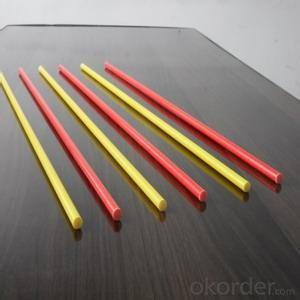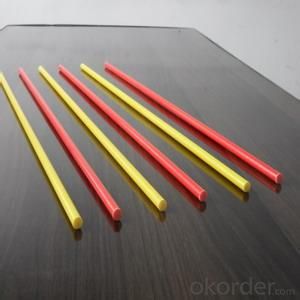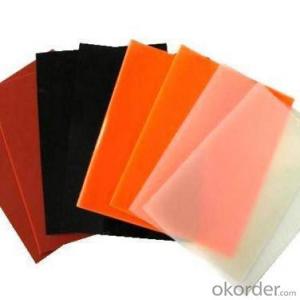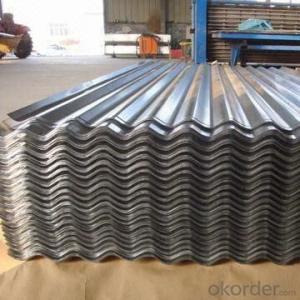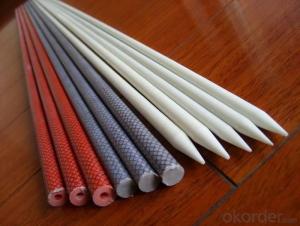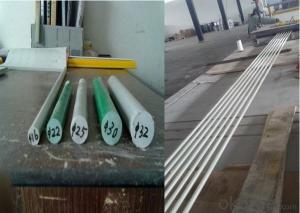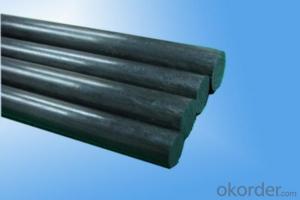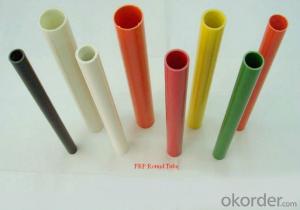FRP Pultrusion Profiles - Excellent Tree Fiberglass Stake
- Loading Port:
- China Main Port
- Payment Terms:
- TT OR LC
- Min Order Qty:
- -
- Supply Capability:
- -
OKorder Service Pledge
OKorder Financial Service
You Might Also Like
Specifications of Excellent Tree Fiberglass Stake:
1.Light Weight
2.High Strength
3.Low Deformation Rate
4.Anti-corrosion and Insulation
Characteristics of Excellent Tree Fiberglass Stake:
1)High Strength
2)Excellent Heat Resistance
3)Low Water Absorption
4)Low Thermal Insulation Coefficient
5)Anti-corrosion
6)Anti-aging
7)Insulation
8)Security
The Pultrusion Process of Excellent Tree Fiberglass Stake: |
Pultrusion is a manufacturing process for producing continuous lengths of reinforced polymer structural shapes with constant cross-sections. Raw materials are a liquid resin mixture (containing resin, fillers and specialized additives) and flexible textile reinforcing fibers. The process involves pulling these raw materials (rather than pushing, as is the case in extrusion) through a heated steel forming die using a continuous pulling device. |
T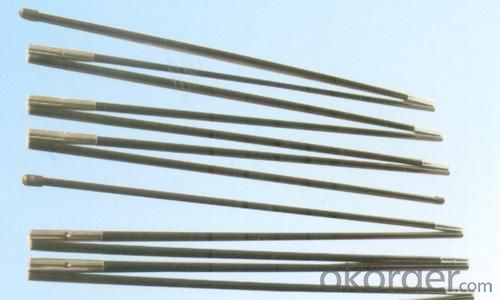
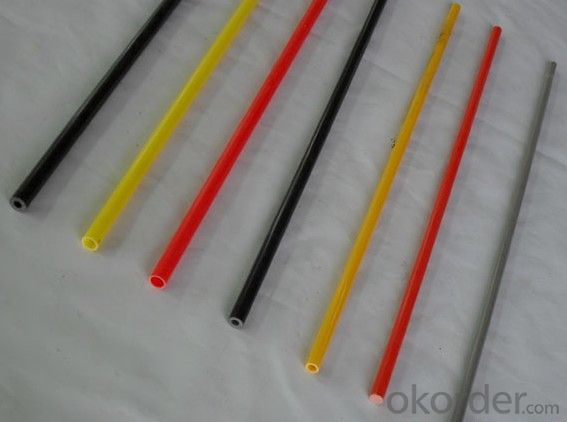
- Q: Can FRP pultrusion profiles be used in the renewable energy and solar power industry?
- The renewable energy and solar power industry can effectively utilize FRP (Fiber Reinforced Polymer) pultrusion profiles. These profiles possess several key characteristics that make them ideal for such applications. To begin with, the high strength-to-weight ratio of FRP pultrusion profiles is crucial in the renewable energy sector. They are lightweight yet strong, allowing them to withstand various environmental conditions while remaining cost-effective. Additionally, these profiles offer excellent corrosion resistance, ensuring durability and longevity in outdoor and potentially corrosive environments like solar power plants or wind farms. Moreover, FRP pultrusion profiles have outstanding electrical insulation properties, making them suitable for electrical applications commonly found in the renewable energy industry. Furthermore, these profiles can be easily customized into various shapes and sizes, enabling the design and engineering of complex structures required for solar power installations or wind turbine blades. Furthermore, FRP materials are non-conductive and non-magnetic, ensuring their safety for use in electrical and magnetic fields associated with renewable energy systems. In conclusion, FRP pultrusion profiles provide a combination of strength, durability, lightweight, corrosion resistance, and electrical insulation properties that make them highly suitable for use in the renewable energy and solar power industry.
- Q: Can FRP pultrusion profiles be used in the construction of elevated walkways?
- Yes, FRP pultrusion profiles can be used in the construction of elevated walkways. FRP (Fiber Reinforced Polymer) pultrusion profiles offer several advantages such as high strength-to-weight ratio, corrosion resistance, and durability, making them suitable for various construction applications including elevated walkways. They are lightweight, yet strong enough to support pedestrian traffic and withstand environmental conditions. Additionally, FRP pultrusion profiles can be easily customized to meet specific design requirements, making them a popular choice in the construction industry.
- Q: Are FRP pultrusion profiles resistant to fading or discoloration?
- Yes, FRP pultrusion profiles are highly resistant to fading or discoloration. The profiles are made with high-quality resins and UV stabilizers that provide excellent protection against sunlight, chemicals, and environmental factors, ensuring long-term color stability and preventing any significant fading or discoloration.
- Q: Are FRP pultrusion profiles resistant to high-pressure water jets?
- FRP pultrusion profiles have a general resistance to high-pressure water jets. Their high strength-to-weight ratio, corrosion resistance, and durability make them suitable for applications involving water and harsh environments. The pultrusion manufacturing process ensures thorough resin impregnation of the fibers, resulting in a dense composite material. This density provides high resistance to water penetration, protecting the material from damage by high-pressure water jets. Additionally, FRP pultrusion profiles exhibit excellent chemical resistance, including resistance to water. This ensures that the profiles will not degrade when exposed to high-pressure water jets for extended periods. It is important to note that the specific resistance of FRP pultrusion profiles to high-pressure water jets may vary depending on the resin and fiber combination used. To obtain detailed information about the resistance of specific profiles in a given application, it is recommended to consult the manufacturer or supplier.
- Q: Can FRP pultrusion profiles be used in the construction of chemical storage tanks?
- FRP pultrusion profiles have the capability to be utilized in the construction of chemical storage tanks. Their exceptional resistance to corrosion is well-known, making them an optimal choice for storing a wide array of chemicals. Pultrusion profiles, created by pulling fiber reinforcements through a resin bath and then through a heated die, possess a high strength-to-weight ratio, dimensional stability, and durability. Most chemicals do not cause a reaction with FRP pultrusion profiles, and they can withstand harsh environments, including exposure to corrosive substances. The profiles have a low permeability, which prevents chemicals from seeping through the tank walls. Moreover, FRP profiles can be customized to meet specific requirements, enabling the construction of tanks in various shapes and sizes. In addition, FRP pultrusion profiles offer other benefits, such as easy installation, reduced maintenance, and a long service life. Being lightweight simplifies transportation and installation processes. The low maintenance requirements of FRP tanks contribute to minimizing downtime and reducing overall costs. With appropriate design and construction, FRP pultrusion profiles can provide reliable and long-lasting solutions for chemical storage tank applications.
- Q: What raw materials do FRP pultrusion require?
- Fiber: pultruded glass fiber roving, continuous felt, stitch woven felt, stitch woven composite felt, fabric, glass fiber surface mat, polyester fiber surface felt, etc.;
- Q: Are FRP pultrusion profiles resistant to weathering?
- Yes, FRP pultrusion profiles are highly resistant to weathering. The pultrusion process creates a strong, durable, and non-corrosive material that is inherently resistant to various weather conditions. FRP (Fiber Reinforced Polymer) profiles are composed of a combination of fiberglass reinforcements and a thermosetting resin matrix. This unique composition provides excellent resistance to UV radiation, moisture, chemicals, and temperature fluctuations, making them ideal for outdoor applications. FRP pultrusion profiles have been extensively tested and proven to maintain their structural integrity and physical properties even after prolonged exposure to harsh weather conditions. They do not degrade, warp, or crack due to sunlight, rain, snow, or extreme temperatures, unlike traditional materials like wood or metal. This weather resistance allows FRP pultrusion profiles to be used in a wide range of applications, including construction, infrastructure, marine, and transportation industries. Furthermore, FRP pultrusion profiles have a low thermal expansion and contraction rate, ensuring dimensional stability in fluctuating weather conditions. This characteristic prevents the profiles from warping or distorting over time, making them an excellent choice for long-term outdoor use. In summary, FRP pultrusion profiles are highly resistant to weathering and offer long-lasting durability in various outdoor environments. Their ability to withstand UV radiation, moisture, chemicals, and temperature fluctuations makes them a reliable and cost-effective solution for a wide range of applications.
- Q: Do FRP pultrusion profiles require any special tools for installation?
- Yes, FRP pultrusion profiles do require special tools for installation. These tools typically include saws for cutting the profiles to size, drills for creating holes, and adhesive application tools for bonding the profiles to the substrate. Additionally, specialized fasteners and brackets may be needed to secure the profiles in place. It is important to use these tools correctly to ensure a proper and secure installation of FRP pultrusion profiles.
- Q: Can FRP pultrusion profiles be used in the construction of conveyor systems?
- Yes, FRP (Fiber Reinforced Polymer) pultrusion profiles can be effectively used in the construction of conveyor systems. FRP pultrusion profiles offer several advantages that make them suitable for such applications. Firstly, FRP pultrusion profiles are lightweight yet strong, making them ideal for conveyor system construction. Their high strength-to-weight ratio allows for easy installation and maintenance, reducing the overall weight of the system while maintaining structural integrity. This feature is particularly beneficial when designing and building long-span conveyor systems. Secondly, FRP pultrusion profiles are highly corrosion-resistant. Unlike traditional materials like steel or aluminum, FRP pultrusions are resistant to rust, chemicals, and moisture. This resistance makes them suitable for conveyor systems that may be exposed to harsh environments or corrosive substances, such as in mining or chemical industries. Another advantage of FRP pultrusion profiles is their electrical insulation properties. They do not conduct electricity, which is a crucial requirement in conveyor systems where electrical components are present. This property ensures a higher level of safety and reduces the risk of electrical hazards. Furthermore, FRP pultrusion profiles can be easily customized to meet specific design requirements. They can be manufactured in various shapes and sizes, allowing for flexibility in conveyor system design. Additionally, FRP profiles can incorporate features such as channels, slots, or reinforcements, which can be advantageous for mounting accessories or facilitating the movement of goods on the conveyor. Lastly, FRP pultrusion profiles are durable and have a long service life. They are resistant to UV degradation and do not require frequent maintenance or painting, reducing lifecycle costs compared to traditional materials. This durability makes them a cost-effective choice for conveyor system construction. In conclusion, FRP pultrusion profiles are an excellent choice for the construction of conveyor systems. Their lightweight, corrosion resistance, electrical insulation properties, customization options, and durability make them a reliable and efficient material for such applications.
- Q: Are FRP pultrusion profiles resistant to humidity or moisture?
- Yes, FRP (Fiber Reinforced Polymer) pultrusion profiles are highly resistant to humidity and moisture. The combination of fiberglass reinforcement and a polymer resin matrix makes them inherently resistant to water absorption. Unlike traditional materials like wood or metal, FRP pultrusion profiles do not swell, warp, or corrode when exposed to moisture or high humidity levels. This resistance to moisture makes FRP pultrusions suitable for a wide range of applications in various industries, including construction, infrastructure, and marine environments. Additionally, FRP pultrusion profiles can be further enhanced with additional protective coatings or surface finishes to provide even greater resistance to moisture and humidity.
Send your message to us
FRP Pultrusion Profiles - Excellent Tree Fiberglass Stake
- Loading Port:
- China Main Port
- Payment Terms:
- TT OR LC
- Min Order Qty:
- -
- Supply Capability:
- -
OKorder Service Pledge
OKorder Financial Service
Similar products
Hot products
Hot Searches
Related keywords
